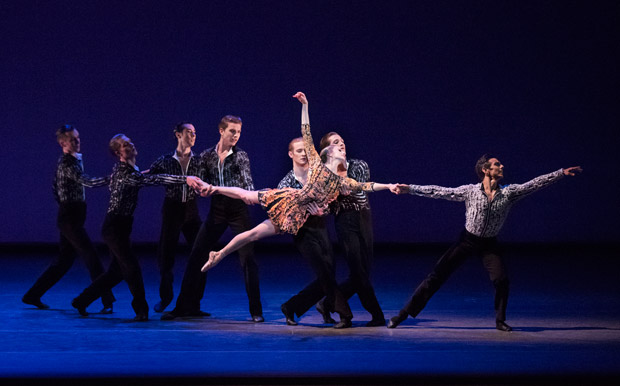
© Paul Kolnik. (Click image for larger version)
New York City Ballet
Square Dance, Tarantella, Odessa, Rodeo: Four Dance Episodes
★★★★★
Washington, Kennedy Center Opera House
6, 11 (matinee) June 2017
www.nycballet.com
www.kennedy-center.org
Last week, New York City Ballet was back in Washington, D.C. for the company’s annual engagement at the Kennedy Center. This was on the heels of their grueling spring season at the Lincoln Center, which included the momentous Here/Now Festival. Still, the company looked spirited and strong. Over the course of NYCB’s seven-performance run at the Opera House, the dancing was universally impeccable – polished, committed and inspiring.
The first of the two mixed repertory programs presented during the run was simply golden. It included two pieces by George Balanchine: the effervescent and charming Square Dance and an exuberant firecracker, Tarantella. The program also featured two ballets that were new to Washington audiences: Alexei Ratmansky’s Odessa and Justin Peck’s Rodeo: Four Dance Episodes.
So far Ratmansky has created five ballets for NYCB; four of them – Russian Seasons (2006), Concerto DSCH (2008), Pictures at an Exhibition (2014) and Odessa (2017) – are set to the music by Russian composers. In his new work, Odessa, which NYCB premiered at the Here/Now festival in May, the choreographer returns to the oeuvre of his friend and collaborator, Leonid Desyatnikov, whose composition inspired the groundbreaking Russian Seasons. Yet unlike Russian Seasons, where the predominant mood is bright and uplifting, the eloquently bleak Odessa leaves you with a sense of tragedy and grief.
Odessa takes its title, and its inspiration, from the literary works of Isaac Babel (1894-1940), the Jewish writer who, like no one else before or after him, poeticized his native city – a port on the Black Sea, and “the most charming city of the Russian Empire.” His “Odessa Tales,” a set of exuberant novellas about Jewish gangsters, written in the 1920s, focused on the fast-moving life of the criminal world of Odessa. In 1990, Russian producer Alexander Zeldovich made a film, Sunset, based on the themes of Babel, for which Leonid Desyatnikov composed the music. A year later, the composer rearranged the film score as a symphonic suite titled “Sketches to Sunset;” and it is to this music Ratmansky has set his new ballet.

© Paul Kolnik. (Click image for larger version)
As with most of Ratmansky’s abstractions, the obvious question arises while watching Odessa: What is the story about? Part of the fascination and pleasure in watching Ratmansky’s works is trying to piece together narrative meaning from all the astonishing choreographic imagery that saturates his ballets.
On the surface, Odessa is an intimate portrayal of three couples entangled in their fierce and desperate games of love, deception and heartbreak. Their personal dilemmas are expressed in dramatic outbursts of passion and frustration, tenderness and violence.
Yet deep down, Odessa is about an impending social crisis – the sunset of society, the end of an era. It’s about the approaching darkness and death; a glimpse at the post-Revolutionary Odessa descending into the deathly grip of Stalin’s terror, with its mass incarceration and murder. Babel himself fell victim to Stalin’s paranoia. He was imprisoned under false accusations of espionage and shot by a firing squad.
The ballet has a silent-movie feel to it and unfolds as a series of poignant, deeply theatrical vignettes, each conveying the emotional highs and lows of the three main couples and their romantic tensions, amplified by shadowy, rippling choreography for the six couples of the corps de ballet.
The costumes (by Keso Dekker, who also collaborated with Ratmansky on his Shostakovich Trilogy) are fetching. The men are dressed to impress, sporting silky black-and-white striped shirts and black pants; the leading women wear short sexy patterned dresses, each in a distinctive shade of blue, green, or amber; the female ensemble is clad in alluring black-and-red numbers with a deep back opening. The gorgeous lighting (by Mark Stanley), dominated by crimson red, manages to evoke both the ambiance of a fancy night club and the flaming colors of sunset. The music switches from aching melancholy to jovial bombast, mixing a variety of styles and textures, with echoes of Mahler, Stravinsky, tango and klezmer.
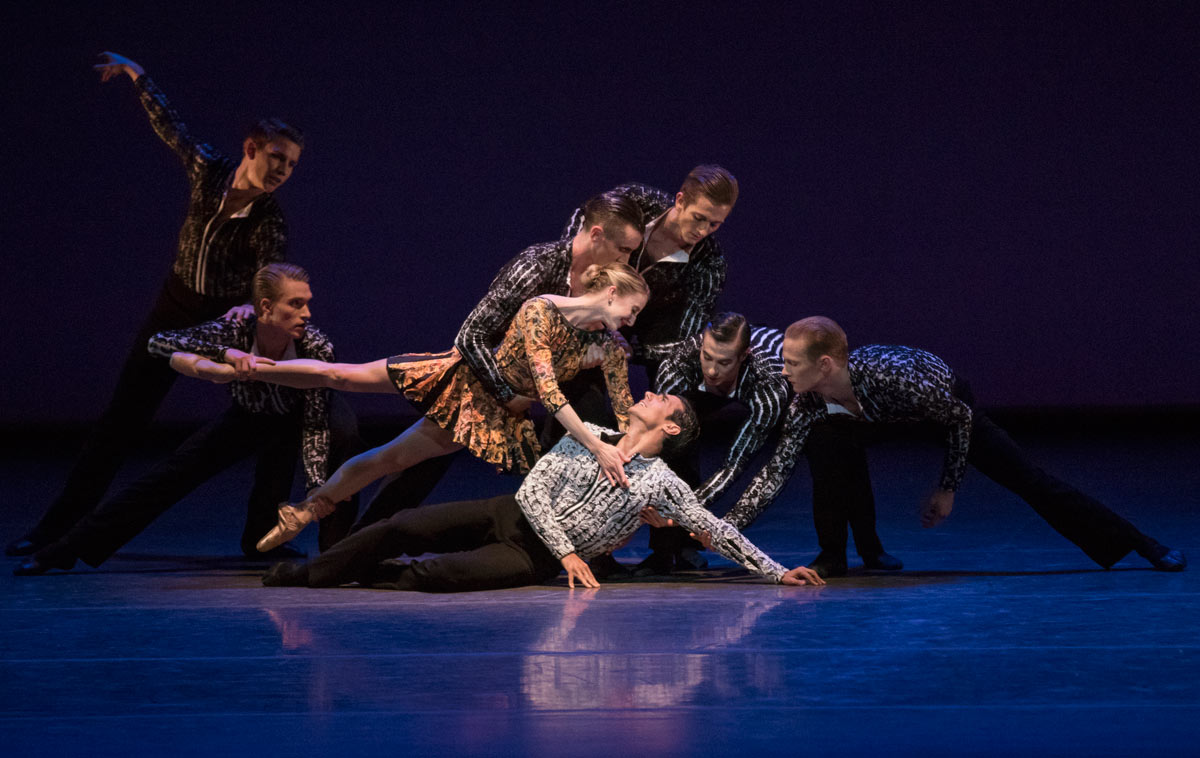
© Paul Kolnik. (Click image for larger version)
In the ballet’s opening scene, the three leading couples enter the stage one by one. One woman (Sara Mearns) slowly sinks into her partner’s lap, another (Ashley Bouder) lets herself be lifted and cradled by her lover (Taylor Stanley); and the third (Sterling Hyltin), overtaken by doubt, is visibly reluctant to submit to her mate (Joaquin de Luz).
It’s this third “hesitant” couple that claims some of the most visually gripping moments of the ballet. In one of them – a dreamlike episode accompanied by lyrical tenderness of violins – both dancers are floating through the air, each being carried aloft by three men of the ensemble. At first, their “expansive” duet looks mesmerizing – it feels as if their love story is finally taking flight and acquiring a deeper meaning, until something goes terribly wrong, and Hyltin ends up being tossed from one man to another, quite ruthlessly and violently, against her will, with de Luz witnessing her brutal ordeal with paralyzing, helpless, awful despair.
The women in this Odessa seem emotionally stronger and more resilient than their thuggish men. Ashley Bouder’s character confirms this in her forceful duet with Taylor Stanley, their encounter looking more like a bitter and angry break-up. He grips her neck and throws her on the floor, menacingly pointing at her an accusing finger; seemingly unfazed, she points right back at him, wishing she had a gun.
The partnership between Mearns and Tyler Angle looks more or less emotionally leveled. They are the tango couple – stylish, sensual, serene, the embodiment of Odessa’s surfeit of glamour. Yet their glory is short lived, their paradise forever lost. In the ballet’s final scene, they lie on the floor next to each other in a bright pool of silver light, as if the earth has already slipped from under their feet.
The ballet closes with a striking tableau, with all the dancers forming a sculpture-like group; and it was up to the audience to decide whether it was a symbol of hope and renewal or a memorial on a mass grave.

© Paul Kolnik. (Click image for larger version)
Odessa left me breathless. The dancing (I saw both casts) was phenomenal on all levels: assured, expressive, and thoroughly dramatic. In the second cast, the tango couple were Unity Phelan and Taylor Angle; the “hesitant” couple, Megan Fairchild and Daniel Ulbricht; and the break-up couple, Tiler Peck and Taylor Stanley. The company is bringing Odessa back for their fall season at the Lincoln Center in October. This is a ballet not to be missed.
Justin Peck’s Rodeo: Four Dance Episodes is exactly what you need in the aftermath of Odessa. This ballet, from 2015, set to the iconic score by Aaron Copland, bubbles with joy and is sheer fun to watch. Turning the classical ballet tradition (a lone hero plus a sizable female corps) upside down, Peck employs 15 guys, outfitting them in sport uniforms (they look like a soccer team), and a single ballerina. They are trusted, life-long friends; and that sense of comradely understanding and support permeates the ballet from start to finish. Peck’s prodigious gift for elaborate and witty ensembles shines at its brightest here, as does his sense of wit and humor.
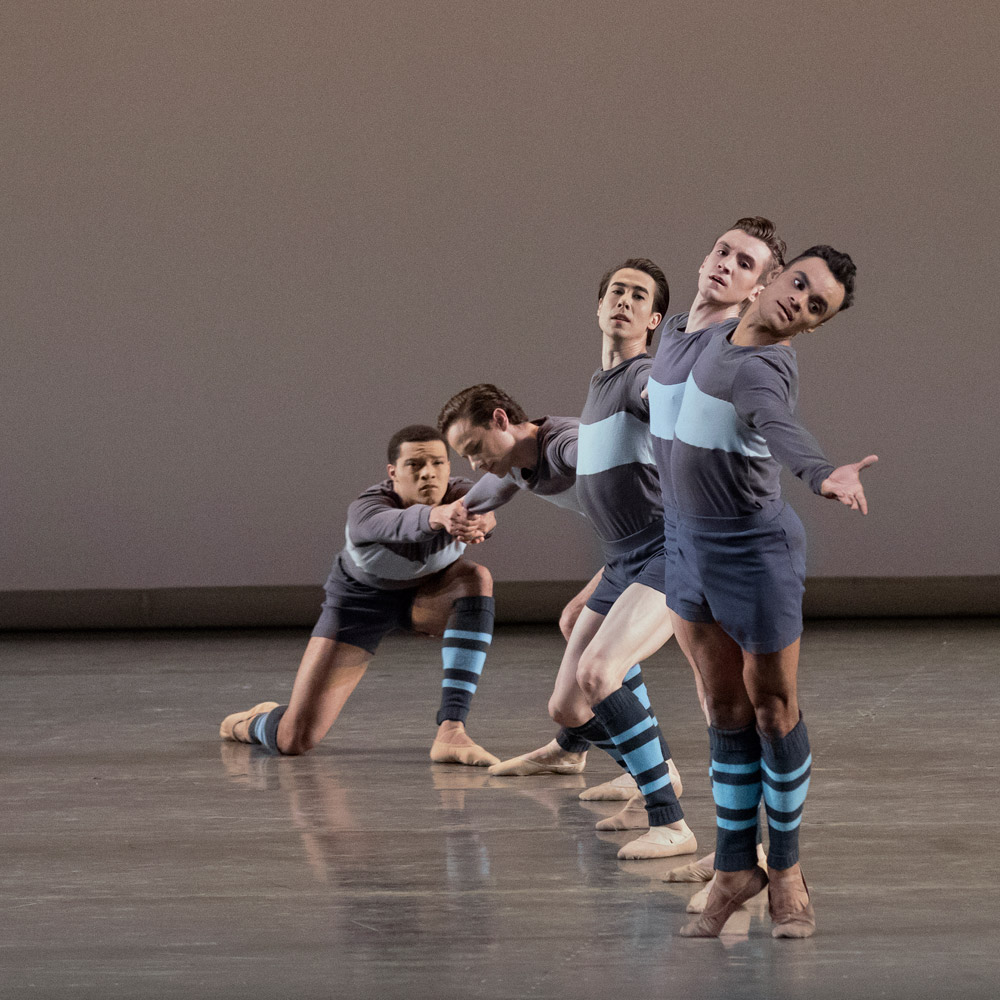
© Paul Kolnik. (Click image for larger version)
The superb Daniel Ulbricht took his usual spot as an implicit group leader, dancing with fantastic skill and bravado. His solo numbers rendered some of the funniest (and most technically taxing) moments of the ballet. Justin himself danced the central male role, filling it with appealing earnestness and great style. He ably partnered Tiler Peck, who in turn was lovely, unaffected, and a real joy to behold. In the second cast, Sara Mearns, who originated the role of the girl, brought a ring of dramatic fervor to the part.
The program opened with a delightful account of Square Dance – Balanchine’s sparkling showpiece of classicism with an allusion to American country social dancing. Set to Baroque music (compositions by Corelli and Vivaldi), the ballet is exquisitely structured, unfolding as a mesmerizing interplay of geometrical patterns for the ensemble as well as a string of fleeting, elegant solos and duets for the leading couple. At all times, the imagery onstage is unpredictable, imaginative, and exciting.
It’s a beautiful ballet and it was danced to perfection by the entire cast. The radiant Megan Fairchild and the stately Chase Finlay were the opening night’s leads; the exuberant Ashley Bouder and Harrison Ball danced the leading roles in the second cast.

© Paul Kolnik. (Click image for larger version)
Tarantella, a brilliant feat of bravura dancing, lasts less than ten minutes but surely delivers a hefty dose of cheer and joy. Always staying in character, Erica Pereira and Spartak Hoxha pulled all the stops, dancing with unstoppable energy and lively panache on opening night. Indiana Woodward and Joaquin de Luz rocked the house, tambourines in hand, in the Sunday matinee.
What a spectacular program!









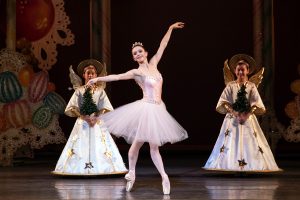
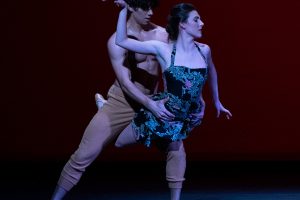
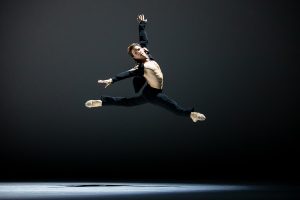



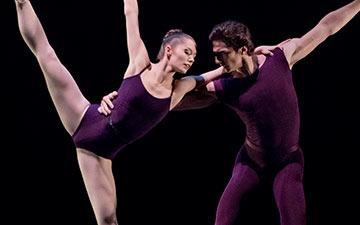

You must be logged in to post a comment.